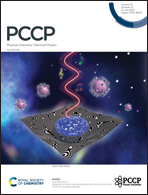A forgotten participant in pore deblocking of zeolites: dicarbonate in NaMeA zeolites, Me = Na, K, Rb, Cs†
Abstract
The dynamics of carbon dioxide, carbonate anion (CO32−), and dicarbonate anion (C2O52−) in NaKA zeolite is studied at the DFT GGA level using ab initio molecular dynamics (AIMD). We show the easy formation of C2O52− dicarbonate from the reaction between CO32− and CO2 at high CO2 loading and their equilibrium at low CO2 loading. We have found that the dicarbonate anion can contact up to six cations (Me+ and Na+, Me = Na, K, Rb, Cs), which could reduce the separation properties of NaMeA zeolites relative to CO2 mixtures. The K+ interaction with dicarbonate C2O52− species pushes the cation from 8R site in full analogy with the carbonate's deblocking studied earlier. The easy C2O52− formation in NaMeA is confirmed by modeling reaction of C2O52− formation at the DFT GGA (PBE-D3) and hybrid levels (B3LYP, HISS, HSE06) with cNEB. The calculated intensities for high and low frequency branches of valence vibrations in C2O52− are compared with calculated ones for Me2C2O5 molecules and known IR spectroscopic data in the NaMeA zeolites. This new mechanism of deblocking could be important for a wide family of narrow pore zeolites (CHA, RHO, KFI, etc.) at room temperature where the carbonates are observed in the IR spectra. The possibility of tricarbonate formation is discussed.



 Please wait while we load your content...
Please wait while we load your content...